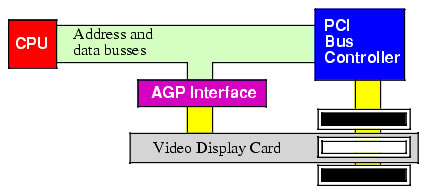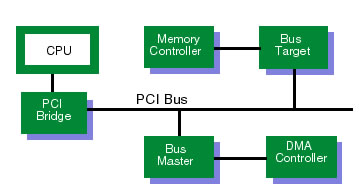Difference between AGP Bus and PCI Bus
Key Difference: AGP (Accelerated Graphics Port) and PCI (Peripheral Component Interconnect) buses are based on two different technologies of connecting expansion cards to the computer. AGP is not considered to be a bus as it is connected to only one device. However, it can be referred to as an interface. PCI bus and AGP differs on many aspects and AGP is preferred over PCI for rendering of complex graphic information.
 AGP and PCI are technologies that are used to connect expansion cards like video and graphics cards to the PC. AGP stands for Accelerated Graphics Port. AGP defines a high speed and point to point channel designed for Video cards and 3D accelerators. It is not considered as a bus as it connects only one device (video card). However, it is based on the design of a PCI bus; the specification of AGP is based on the PCI 2.1 specification. Intel launched the AGP’s first version in July 1996. This bus was designed to increase the transfer rate of the video cards; in the case of PCI bus, the transfer rate was limited to 133 MB/s. This is also shared among the devices connected to the bus, resulting in even lower transfer rate.
AGP and PCI are technologies that are used to connect expansion cards like video and graphics cards to the PC. AGP stands for Accelerated Graphics Port. AGP defines a high speed and point to point channel designed for Video cards and 3D accelerators. It is not considered as a bus as it connects only one device (video card). However, it is based on the design of a PCI bus; the specification of AGP is based on the PCI 2.1 specification. Intel launched the AGP’s first version in July 1996. This bus was designed to increase the transfer rate of the video cards; in the case of PCI bus, the transfer rate was limited to 133 MB/s. This is also shared among the devices connected to the bus, resulting in even lower transfer rate.
This bus provides the channel through which a graphic controller can directly interact with the system memory. It is fitted into the motherboard and can be considered as the actual expansion slot. Motherboard must support the AGP video card for proper functioning.
 On the other hand, PCI (Peripheral Component Interconnect) bus was introduced in 1990 as a cross of ISA and VL-bus. It defines a path through which graphic cards can interact with the CPU. This type of bus can send multiple packets of information and that too from various sources. They all make use of a single path simultaneously. After reaching to the CPU, the information has to wait to get time from CPU. The bus is either a 32 or 64 wide with multiplexed address and data lines. The data through this bus can be transferred continuously for large bursts. The mechanism followed for the transfer can be referred to as a burst. It consists of an address phase and one or more data phases. The interface of PCI contains 256-byte configuration memory which is capable of exhibiting plug and play feature.
On the other hand, PCI (Peripheral Component Interconnect) bus was introduced in 1990 as a cross of ISA and VL-bus. It defines a path through which graphic cards can interact with the CPU. This type of bus can send multiple packets of information and that too from various sources. They all make use of a single path simultaneously. After reaching to the CPU, the information has to wait to get time from CPU. The bus is either a 32 or 64 wide with multiplexed address and data lines. The data through this bus can be transferred continuously for large bursts. The mechanism followed for the transfer can be referred to as a burst. It consists of an address phase and one or more data phases. The interface of PCI contains 256-byte configuration memory which is capable of exhibiting plug and play feature.
Comparison between AGP and PCI:
|
|
AGP |
PCI bus |
|
Definition |
AGP stands for Accelerated Graphics Port. It is a graphic hardware technology that got introduced in 1996. It defines a high speed and point to point channel designed for Video cards and 3D accelerators. |
PCI stands for Peripheral Component Interconnect. The PCI bus architecture has been fully standardized by the PCI Special Interest Group. It is a technology that developed on the features of ISA and VL-bus based technologies. |
|
Main purpose |
Solely for use with graphics cards |
General I/O interface bus |
|
Type |
A point to point connection |
Bus |
|
Pathway |
A dedicated one between the slot and the processor |
Sharing the PCI bus |
|
Graphic Operations |
Comparatively faster |
Comparatively slow |
|
Peripheral Devices |
Comparatively faster |
Comparatively slow |
|
Quality of 3D graphics |
Comparatively high |
Comparatively low |
|
Requests |
Pipelined |
Non pipelined |
|
Address/Data |
De-multiplexed |
Multiplexed |
|
Priority Queues |
High/low |
No priority queues |
|
Number of requests Made |
Multiple requests for data during a memory access |
One request |
|
Bandwidth |
Not shared with other devices |
Shared with other devices |
Image Courtesy: eurekatech.com, plantation-productions.com









Add new comment